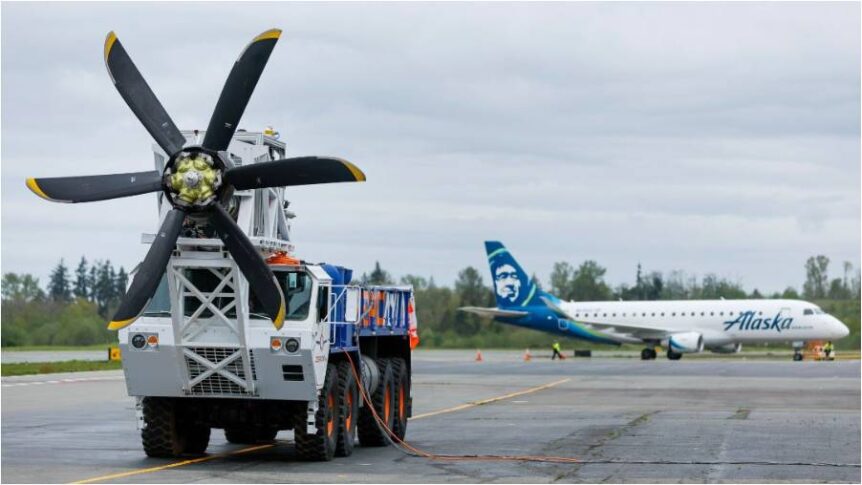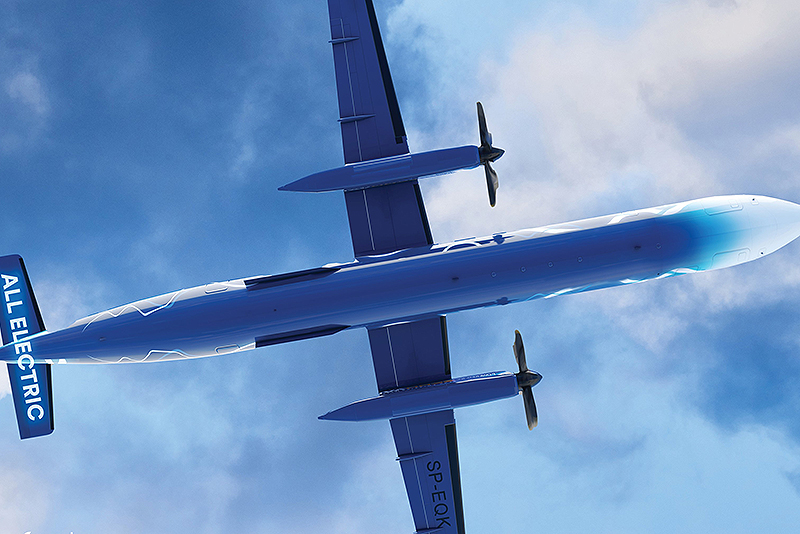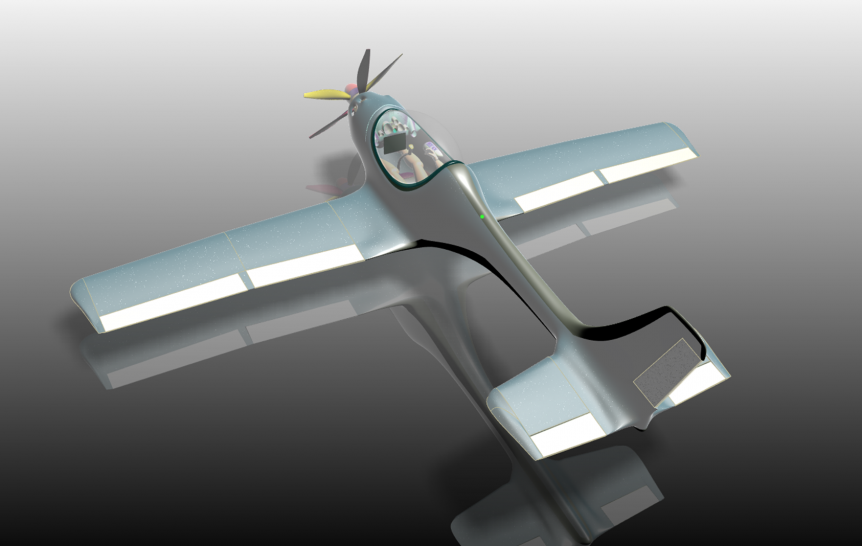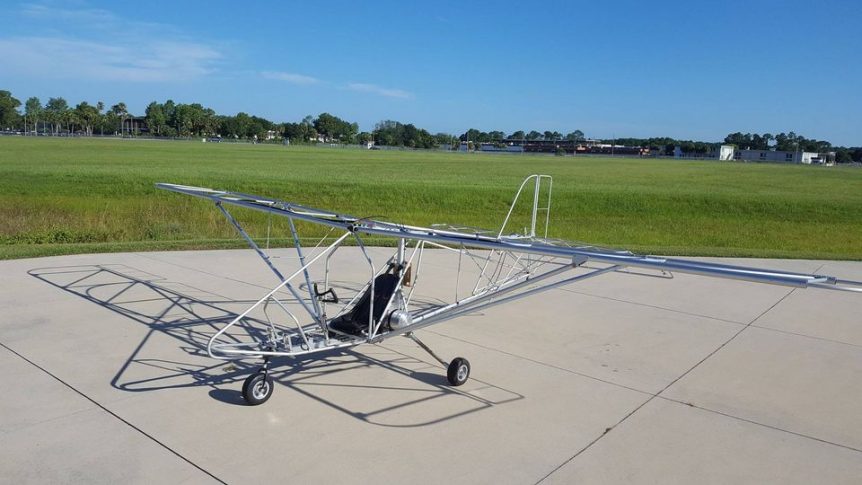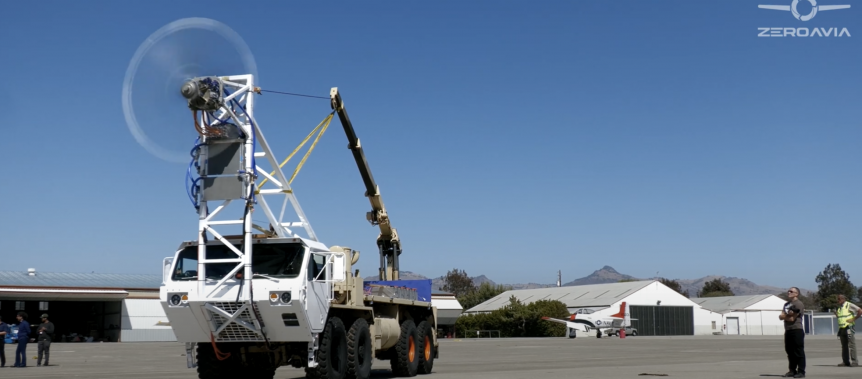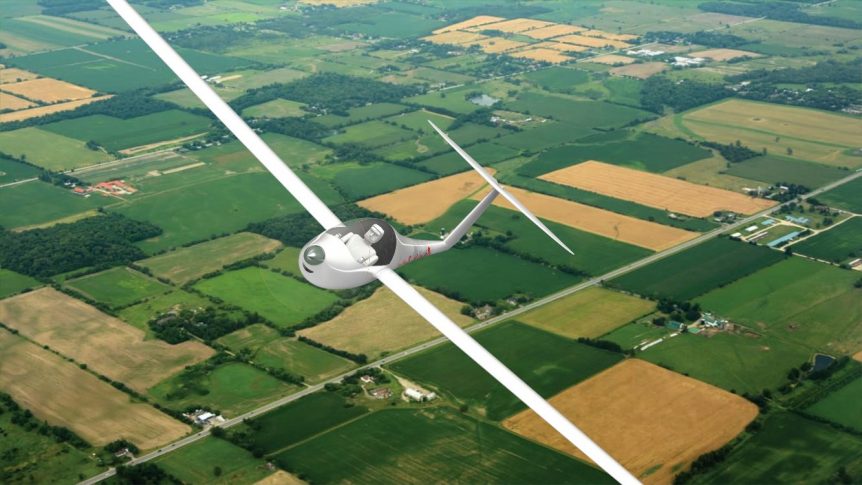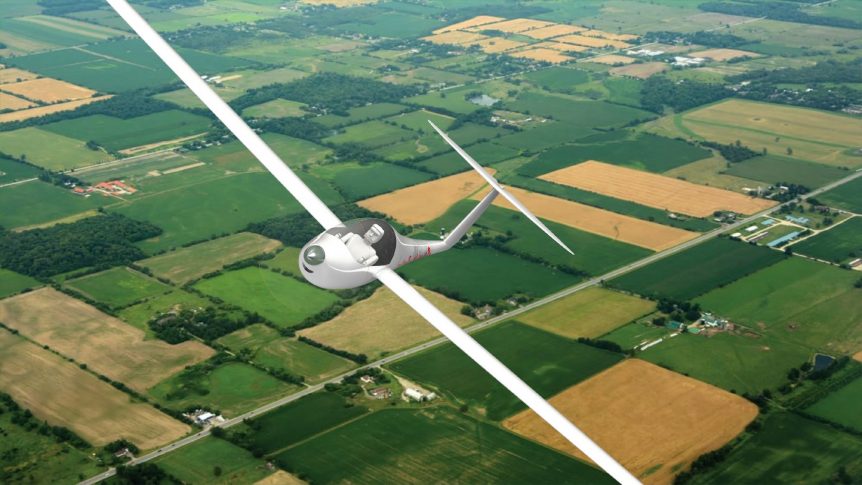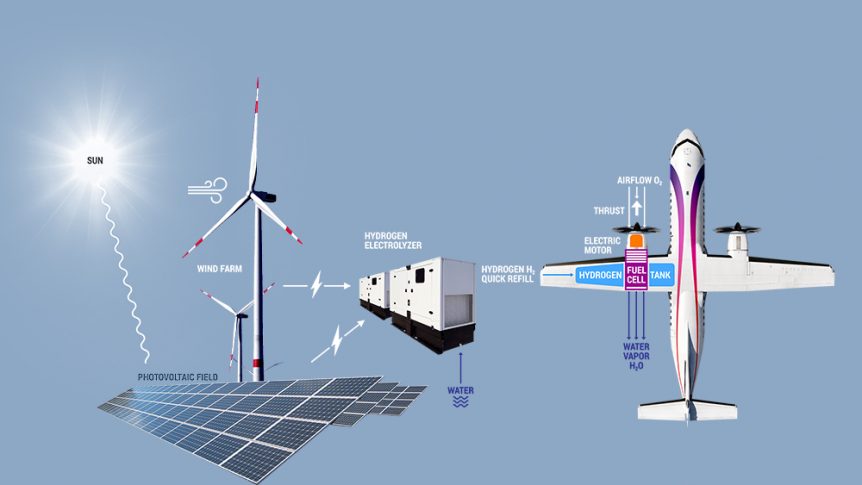ZeroAvia has taken delivery of a 76-seat Bombardier* Q400 airplane from Alaska Airlines. The craft could become a test bed for ZeroAvia’s modular HyperCore motors and hydrogen fuel systems. The Q400 will carry four times the number of passengers of the company’s current Dornier 228 twin-engine test aircraft – already having made five successful test flights. ZeroAvia proclaims, “The future of flight is renewable hydrogen,” and explains with a mission statement. “From 20 seat regional trips to over 100 seat long-distance flights, ZeroAvia enables scalable, sustainable aviation by replacing conventional engines with hydrogen-electric powertrains.” Two Dorniers, one in the United Kingdom and one in Hollister, California, are undergoing test flights (five so far in the Cotswolds in England) or awaiting FAA approval for such flights in Hollister. Acquiring the Bombardier brought a lot of attention to the Everett, Washington area recently, where ZeroAvia has a development center. Governor Jay Inslee came to inspect the project Q400 and prophecy about an increasingly …
Using Ford F-150 Lightnings to Charge a Pipistrel Alpha Electro
Using Ford F-150 Lightning pickups to charge a Pipistrel Alpha Electro will enable spectators at the Lafayette College-Lehigh football game to see an electric airplane flyover. Remy Oktay wants to perform at his school’s football game, and needs to fly the craft from Hartford, Connecticut to the game in Easton, Pennsylvania. Bringing Your Own Charging Stations Recent attempts to fly reasonably long distances with electric airplanes have shown a few limitations. Aside from the self-recharging craft like Solar Impulse or the Raymonds’ Solar-Flight Duo, planes with rechargeable batteries cannot go far without needing a compatible charger. We reported on several of these distance flight, noting the accommodations each made to fly beyond their home fields. Gabriel DeVault made a California outing into a search for viable charging station. Friend Bob Mackey flew a Maule along the route, carrying a charger to keep Gabriel’s eGull going. A Swiss team flew to the North Sea, with chase cars lugging their charging gear …
Sonex and Gabriel DeVault Partner on Electric Kitplane
Sonex and Gabriel DeVault have partnered to create an electric kitplane, marketing components for a different type of powerplant. Sonex has been in the kitplane business since 1998 (having built from a decade’s-old earlier company) and Gabriel DeVault has been working with the electrification of aircraft for a decade. Combining their expertise, we have a kit built path toward an inexpensive electric kitplane. Gabriel commutes a lot by air, traversing the globe between his home in Watsonville, California and Cranfield, England for work on Zero Avia’s electrification of Dornier 228s – one in each country. He flies between Watsonville and Hollister, California in his Zero Motorcycle powered eXenos, a kit built product from Sonex Aircraft in Oshkosh, Wisconsin. Before that, he flew a Mark Beierle eGull powered with a Zero motor. Gabriel was instrumental in the design and manufacturing of that motor, making him a bona fide expert on the powerplant. His experience with the eXenos has led Sonex to …
ZeroAvia, Mitsubishi, and Alaska Airlines Power Up
A Different Type of Kitplane Green Aeronautics are moving beyond small beginnings into grander realms through ZeroAvia, Mitsubishi, and Alaska Airlines. Gabriel DeVault has flown two different electric airplanes of his own, a converted EarthStar Thundergull and a Sonex eXenos (which seems to be his daily commuter between Hollister, California and his home in Watsonville). Both have been featured prominently in his YouTube channel and your editor has written about them for Kitplanes magazine. Now, Gabriel is working on a different type of Kitplane at a much large scale. Gabriel managed research and design for the motor and related systems on the Zero electric motorcycle. The original unit has gone through several upgrades, and is now seen in variants from 27 to 110 horsepower. The company sold over 4,000 units last year in 30 countries including the United States. They look to build at an accelerated rate, hoping to double sales every year. He has taken that expertise to larger …
Would an Electric LSA Kit Appeal to You?
Is there a need and desire for an electric light sport aircraft (LSA) kit that is inexpensive to own, operate, and maintain? Electric flight already offers that possibility, and if kits were available to further lower costs, we could see a new way to achieve low-cost flight. The LSA designation qualifies a builder to take advantage of LSA’s lighter constraints. A good friend who happens to have designed an electric Light Sport Aircraft (LSA) a few years ago let the project lapse because of the need to tend to other business interests. He wants to know if there’s a market for a new, improved version of his original concept – an electric LSA that would fly for considerably less in operating costs than an internal-combustion model, and that would provide reliable, safe sport flying. He provided the following survey to the Experimental Aircraft Association, which created the link at the end of this entry. His comments follow. “This survey is …
Aerolite 103 – As Simple As Aerial EVs Get
Shown and flown at this year’s Sun ‘n Fun and AirVenture, the Aerolite 103 is a well-tested, best-selling ultralight that in FAA Part 103 form is a true ultralight. As an electric aircraft, it’s heavier and faster than accepted ultralight standards but no less a competent flyer registered in the Experimental category. Designed in 1996, and with hundreds of the original two-stroke engine-powered versions flying, Aerolite’s originator Terry Raber sold the rights to Dennis Carley in 2012. Manufacturing moved from Millersburg, Ohio to Delano, Florida. The airplane retains its position as an inexpensive FAA Part 103-compliant ultralight – true to its name. In the last few years, it has also become part of zero-emission flight. Aerolite as an EV One can only wonder where Gabriel DeVault finds the time. Currently working in Hollister, California and Cirencester, England on ZeroAvia’s hydrogen-fueled aircraft, Gabriel was also powerplant developer for Zero Motorcycles. His motors now power several homebuilt aircraft, including his personal eGull …
ZeroAvia Tests 600 kW Motor, Receives Honors
Val Miftakhov, founder and CEO of ZeroAvia, introduces tests of the company’s 600 kilowatt powertrain, mounted high atop their new mobile test bed. In recent months, the company has achieved some solid recognition. “In July, 2021, ZeroAvia has successfully tested high-power operation of its flight-intent ZA-600 (600kW) powertrain. The testing has been done on the brand new HyperTruck mobile ground testing platform ZeroAvia has developed based on a heavy-duty M977 HEMTT military truck. The HyperTruck platform is designed to be able to test not only the current 600 kilowatt system for 10-20 seat applications, but also the 2 Megawatt system currently in design phase, targeting 50-80 seat aircraft. The latest series of tests signifies a critical milestone before flight application of these powerplants later this year in the company’s 19-seat test demonstrator.” Further down the line, plans for a 40-80 seat hydrogen-electric aircraft are in store. Perhaps the high mounting of the powerplant comes from Head of Drivetrain development, Gabriel …
Spark Solo Gets ZeroAvia Sponsorship
Mike Friend, retired Technology Director for Boeing Aircraft, and Gabriel DeVault, head of drivetrain development for ZeroAvia, are putting a Zero motorcycle motor into Mike’s Spark Solo. There are perhaps dozens of Zero motors flying today, and the 42-pound unit has evolved to powering even two-seat motorgliders like Gabriel’s Sonex Xenos. An Ambitious Project Mike came up with the Spark Solo design as a way to, “Encompass the design process” as well as the “piloting and fabricating” aspects of a project. He wanted to, “Define an airplane uniquely designed around electric propulsion,” noting that, “Past efforts have almost always been adaptations of internal-combustion powered airplanes.” To help forward his design, Mike has been working with his local EAA chapter, for which he is past president. Experimental Aircraft Association (EAA) chapter 406, “Is creating BACE (Bremerton Aviation Center for Education), a place where people can come to learn hands-on skills in airplane design, construction, and maintenance. Our shop area and flight …
Michael Friend’s Spark Solo
“The Quest for a Truly Practical Electric Touring Motor-Glider” Mike Friend is not your typical retired aircraft executive. As Technical Director for Boeing, he oversaw “the first manned fixed wing aircraft powered by a hydrogen fuel cell/lithium ion battery powerplant that first flew back in 2008.” He’s been associated with green energy projects since then, including work on the Boeing-supported Zunum project, a set of 10- to 50-passenger electric hybrid airliners. On the personal front, he hopes to design and build the Spark Solo, a single-seat electric motorglider that will enable cross-country flights from his home base of Bremerton (Washington) Regional Airport. Working with Gabriel DeVault Motorgliders make a good combination with battery power. Their clean lines enable using low power at cruise, and as this video from Gabriel DeVault shows, even a respectable takeoff and climb with power limited to 25 kilowatts (33.5 horsepower) in this instance. Normally, DeVault’s Sonex would make full use of its Zero Motorcycle motor’s …
ZeroAvia Gains Backing at High Levels
“Cannot be more proud and humbled to be a part of this stellar team!” That’s power system developer Gabriel DeVault’s response to ZeroAvia’s Chief Financial Officer Katya Akulinicheva’s enthusiastic endorsement of Bloomberg LP’s news. She listed the investors taking an active interest in ZeroAvia, including Ecosystem Integrity Fund, Breakthrough Energy Ventures, the Amazon Climate Pledge Fund, Horizons Ventures, Shell Ventures and Summa Equity. Already benefiting from a $16.3 million grant from Innovate UK, Aerospace Technology Institute and Department for Business, Energy and Industrial Strategy (BEIS), ZeroAvia will be able to push forward on plans to create a 19-seat hydrogen-powered commuter liner. According to Bloomberg, “ZeroAvia aims to demonstrate that it can fly a plane 500 miles (804 kilometers) with as many as 20 seats by 2023. It wants to scale up to 1,000 miles with over 100 seats by 2030.” With individuals such as Bill Gates and Jeff Bezos taking an interest, an aviation blog now feels a little like …
- Page 1 of 2
- 1
- 2

